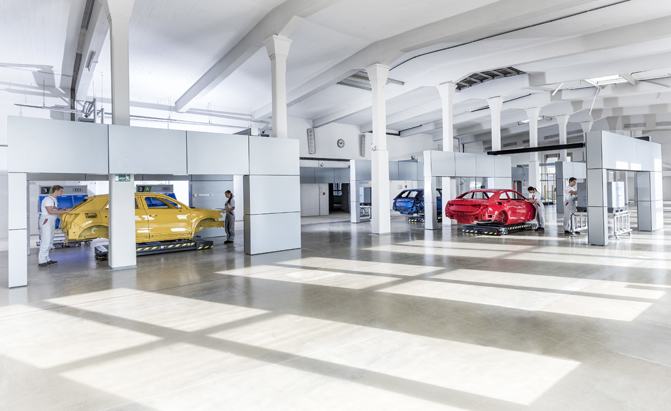While automotive manufacturing may have more than 100 years of history under its belt, it could see a radical change if Audi has its way, as the automaker is exploring the idea of ditching the assembly line altogether.
While not exactly a new concept — the Volkswagen Group division has been experimenting with the idea for a few years now — the inaugural Audi Summit in Barcelona, Spain, provided a clearer picture of the modular assembly approach currently under development that could soon find its way into the carmaker’s plants. It’s all part of what Audi calls its “production network of the future,” where everything we think we know about auto assembly is scrapped in favor of manufacturing processes that are as unique as they are ambitious. In fact, some of them seem downright counterintuitive.
Bye-Bye, Assembly Line
Take Audi’s modular assembly concept, for example. It’s one that flies directly in the face of the linear assembly line that’s been a crucial component of auto production for more than a century. Instead of a series of stations where each step in the assembly process is completed in succession, Audi envisions individual workstations that operate independently of each other — and ones that aren’t connected by any physical lines or conveyors. Instead, driverless transportation systems would move the vehicles and components around the factory floor from one workstation to the next.
According to the automaker, modular assembly is a solution is to the growing problem of model diversity. “The more the number of derivatives and variants grows,” according to Audi, “the more difficult it becomes to master high complexity and integrate new routines into the rigid, sequential process.”
ALSO SEE: Tech-Filled 2018 Audi A8 Debuts With Robust Self-Driving Suite
Take, for example, the Audi A3 produced in Ingolstadt, Germany. Not only is the compact car available in sedan, hatchback, and convertible versions, but it’s also available in a variety of vastly different powertrains, including a plug-in hybrid version. When the latter, a five-door hatchback, makes its way down the line, it needs more time for wiring its various electrical systems, slowing down the assembly line as a result.
Audi claims modular assembly would do away with this issue while also allowing it to avoid further delays by redirecting vehicles to vacant workstations to continue a steady workflow. In fact, the automaker expects productivity would be improved by 20 percent if modular assembly was adopted in its plants.
The concept of modular assembly is currently being fine-tuned by a startup Audi holds a stake in, with plans to implement it at an engine production plant in Hungary in the near future. The automaker also says it has two other undisclosed projects in the pipeline where modular assembly will be implemented.

Painting On-Demand
In the same vein is Audi’s so-called “paint shop of the future.” While paint departments at auto plants follow a similar production line principle as the assembly process itself, the automaker wants to execute a modular strategy where cars are painted on-demand as opposed to in sequence.
Central to the concept is a main storage area where car bodies are kept like shoeboxes in a closet. As they’re needed — or, perhaps more accurately, as they best fit the day’s schedule — the bodies are plugged into the production process, where they are painted and sent through a series of progressive drying ovens.
Audi says this modular process not only provides flexibility, but it also allows for a degree of individualization that’s more difficult to manage in a more traditional paint shop. Accommodating requests for unique colors and color combinations like pinstripes in a current paint shop often means forcing the entire line to work its way through all stations even if only a few — or just one — vehicle is actually getting work done.

Have No Fear, Humans Are Still Here
Of course, any discussion about the future of manufacturing invariably includes a heavy dose of robotics. But that doesn’t simply mean building a plant where robots run everything; instead, it’s one that utilizes the best assets of humans and robots together in the same space.
While Audi hasn’t specified what impact these future plans could have on staffing, it’s clear that manpower will still play a central role. The modular assembly process would still see “one or two workers” in each workstation — no different than most stations in a traditional assembly line.
ALSO SEE: The Most Popular Automaker in the World Isn’t a Big Surprise
As a result, the automaker is also working on ways to make human jobs just a little less strenuous. And one such way is the so-called “chairless chair,” an exoskeleton-like set of legs that would allow employees to sit on the job — literally. Made of two small seat surfaces and two struts made of carbon fiber-reinforced polymer (CFRP), the chairless chair can be actuated at the push of a button to allow workers to sit instead during certain assembly jobs.
And, of course, Audi figures wearable technology will also play a major role in its production network of the future, with items like gloves with built-in barcode scanners and virtual reality headsets aimed at improving logistics. While it’s all but unavoidable that so-called smart factories will result in a smaller workforce on the production floor, the future of manufacturing looks to be in good hands.



Leave a Reply